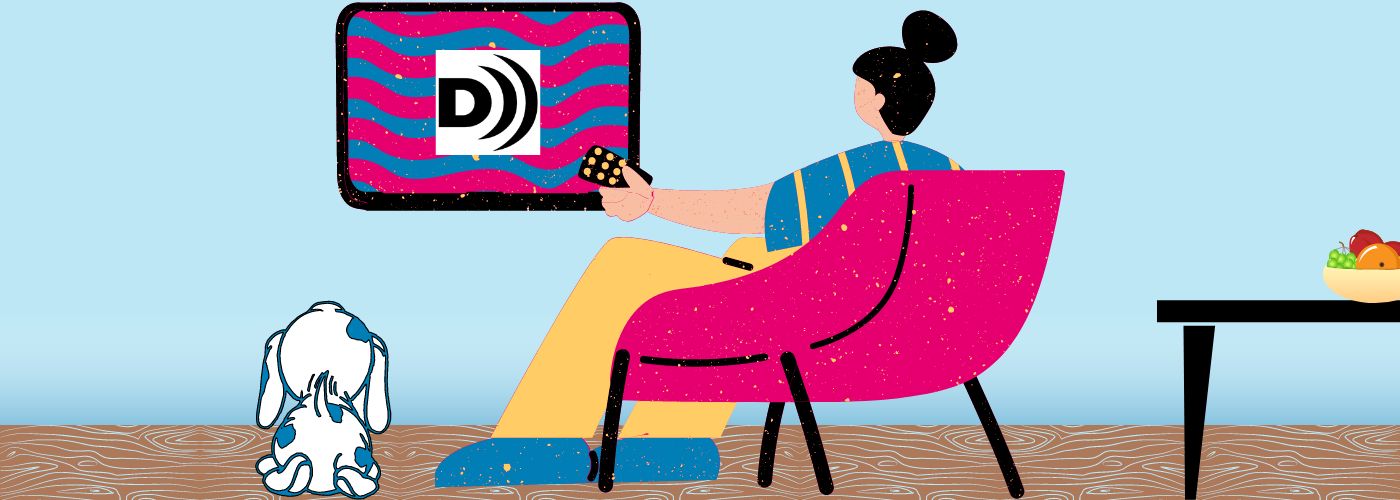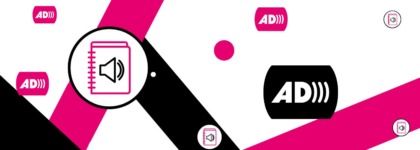What is Described Video?
Updated: February 11, 2023
Intro to Described Video [Free Webinar]
Remember the last time you watched a great movie? Maybe you laughed, maybe you cried, maybe you came out of that experience with a new perspective. Part of why movies can be so captivating and impactful is because of every little detail that goes into a film.
When you watch a movie or television show, it isn’t just the dialogue that explains what’s happening. Non-verbal elements like body language and visual cues play a crucial role in adding context to a storyline that can’t be conveyed through words alone. But what about if a viewer is blind? With described video, viewers can listen along and fully immerse themselves in the story—regardless of whether they can see the screen.
What is Described Video?
Described video (DV) is an accommodation for blind and low-vision viewers that narrates the important visual information of a program. Also referred to as “audio description” or “description,” DV assumes the viewer cannot see the on-screen content and was created to give users a fulfilling and comprehensive viewing experience. For people who are blind or low-vision, video description is key to receiving detailed information that sighted people consume with their eyes.
Described video is narrated during pauses in dialogue and enables viewers to conjure a mental picture of the program. This allows the individual the benefit of the description without sacrificing the information in the existing content. There are many ways to add DV to your videos, including using a secondary audio track, a WebVTT description file, and more.
Press play to watch a great example of described video in action, featuring everyone’s favorite Frozen snowman: Olaf!
Canada’s Described Video Requirements
The Canadian Radio-television and Telecommunications Commission (CRTC) first began requiring minimum levels of described video content from particular broadcasters in 2001. Regulations were revisited in 2009, with a policy specifying that:
- Broadcasters must provide described video for all in-house productions related to information-based programs
- All conventional broadcasters, as well as certain French and English pay and specialty broadcasters, must offer four hours of described video per week, and are encouraged to make described programming available online
- Broadcasters are expected to display the described video logo and announce the start of a described program
The final phase of DV requirements became active in September of 2019. Thanks to the CRTC’s Let’s Talk TV initiative, certain Canadian broadcasters must now provide described content for relevant programming during prime time hours (7pm to 11pm), seven days a week. Newscasts and sports are exempt from these requirements.
Broadcasting distributors are also required to make accessible hardware available to their subscribers, provided they’re compatible with distribution systems. This requirement is a part of the broadcasting distribution undertaking (BDU) regulations:
The country also passed the Accessible Canada Act in May 2019 with the goal of creating a barrier-free Canada by the year 2040.
The AODA
The Accessibility for Ontarians with Disabilities Act (AODA) is an accessibility law based in Ontario that regulates standards across government, public, and private sectors to create a barrier-free Ontario by 2025. Under the AODA, all website and web content must comply with WCAG 2.0 level AA.
DV or text transcripts that include audio and visual elements must be provided for all pre-recorded video content published by Ontario-based organizations. While visual elements must be made accessible to blind or low-vision audiences, the AODA does not explicitly require designers to provide described video. However, doing so affords those who use the service an enjoyable, accurate, and more accessible viewing experience, unlike providing a simple text transcript.
The AMA
The Accessibility for Manitobans Act is landmark legislation that provides a process for identifying, removing, and preventing barriers to accessibility across the province. The AMA became law in 2013 and delineates accessibility standards in five key areas.
Under the AMA, an organization’s web content and applications must meet or exceed the standards set out in WCAG 2.1 Level AA. This means that online video must provide described video for all pre-recorded video content in synchronized media.
Get the rundown on described video [FREE webinar]
The Benefits of Described Video
Though described video was originally intended for people who are blind or low-vision, DV has proven to be beneficial for a much broader audience.
Accessibility for Blind and Low-Vision Viewers
According to the World Health Organization, at least 2.2 billion people are living with some form of vision loss. Described video meets accessibility requirements so that viewers who are blind and low-vision can access your content.
Without described video, your content becomes inaccessible to a large group of people who want to engage with your video. These are potential viewers you could be excluding.
Improved Learning
Research has proven that the brain processes information through visual and auditory channels. When you watch a DV-enabled video, you can accommodate and process a greater amount of new information.
20-30% of students say that they retain information best through sound. Described video is a helpful aid for auditory learners and can assist all individuals in acquiring new information as they watch educational material.
The Autism Spectrum
In addition to serving as a learning aid, described video can also benefit autistic individuals by providing information about emotions and social cues.
Folks with autism often struggle with understanding human emotions and social interaction. Non-verbal communication can reveal a lot of information, so someone who can’t interpret these cues may have difficulty understanding emotions, such as if a character feels angry, sad, or entertained.
Since DV is designed to provide purely visual information in an auditory track, a describer might dictate that someone “walked into the room with a frown on their face.” This description can be useful for autistic viewers, as it might help them recognize an emotion that may be difficult for them to identify.
Providing additional viewing support through described video allows autistic viewers to enjoy videos without relying on others to answer questions such as ‘What does that mean?,’ ‘Who’s that?,’ and ‘Why did that happen?’
Improved Multitasking
Sighted people often watch TV as background noise while engaging in other tasks such as cooking, exercising, or cleaning. It’s easy to miss visual information in these scenarios because the viewer’s full attention likely won’t be on the screen at all times.
Described video provides a great solution, as the viewer’s eyes don’t have to be on the screen every second to understand a video. Like audiobooks, DV of TV shows or movies can also benefit a driver who can’t take their eyes off the road.
Language Development
Listening and associating words with appropriate actions and behaviors is a key step in language development. Described video can be a useful pedagogical tool to enhance language development in children by providing reinforcement and introducing new vocabulary. DV can also provide a dynamic experience for students to engage and become more involved in their own learning.
If you want to learn more about described video, 3Play Media has a vast collection of resources. 3Play Media also offers a reliable, cost-effective DV service with easy to use features and consistently high quality. Here are a few of our resources:
-
- 10 Questions to Ask an Audio Description Vendor [FREE eBook]
- The Ultimate Guide to Audio Description
- How to Select an Audio Description Vendor
- Why Customers Love Our Audio Description Service
- How to Add Audio Description (W3C-Approved Techniques)
- Audio Description as a Form of Audiovisual Translation with Dr. Joel Snyder






